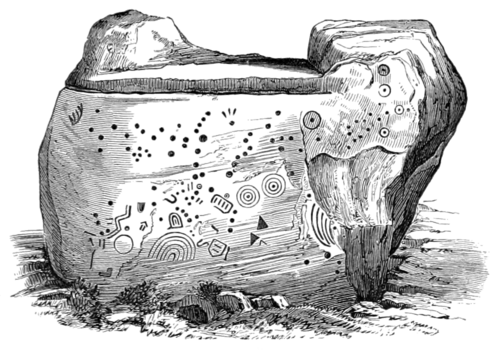length. They are not detached, as at New Grange, but form a retaining wall to the mound. On the north, and set about 4 feet back from the circle, is a large stone, 10 feet long by (5 high, and 2 feet thick, weighing consequently above 10 tons. The upper part is fashioned as a rude seat, from which it derives its name of the Hag's Chair (woodcut No. 73), and there can be little doubt but that it was intended as a seat or throne; but whether by the king who erected the sepulchre, or for what purpose, it is difficult now to say.
On the eastern side of the mound the stones forming the periphery of the cairn curve inwards for eight or nine yards on each side of the spot where the entrance to the chamber commences. It is of the usual cruciform plan, and 28 feet long from the entrance to the flat stone closing the innermost cell; the dome, consequently, is not nearly under the centre of the tumulus, as at New Grange, and lends something like probability to the notion that the cell at Dowth (woodcut No. 69), was really the principal sepulchre. Twenty-eight of the stones in the chamber were ornamented with devices of various sorts. Two of them are represented on the ac- companying woodcut (No. 74), which, with the drawings on the Hag's Chair give a fair idea of their general character. They are certainly ruder and less artistic than those on the Boyne, and so far would indicate an earlier age. Nothins was found in the chambers

